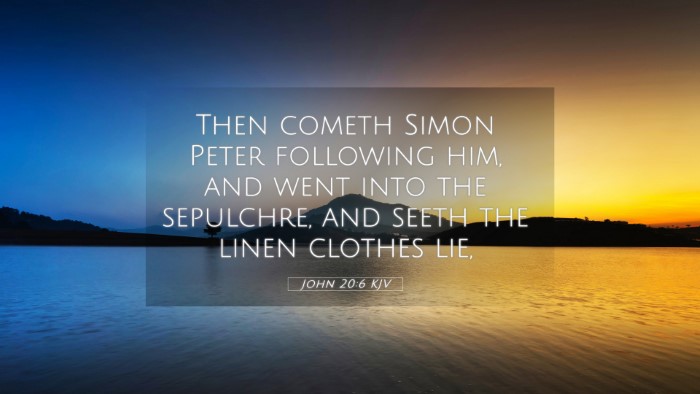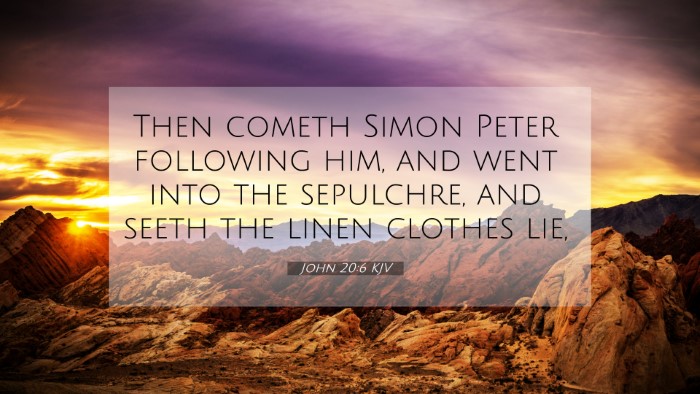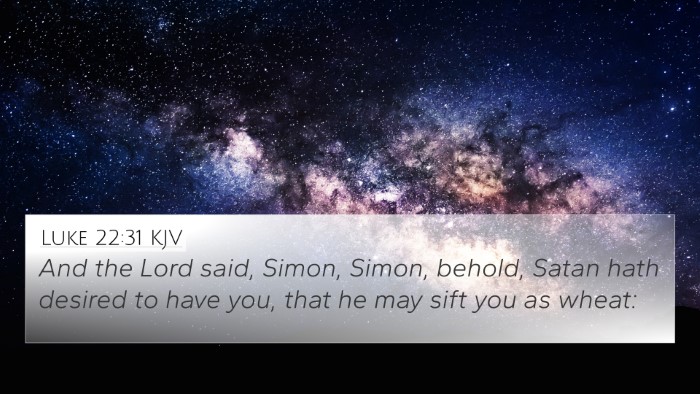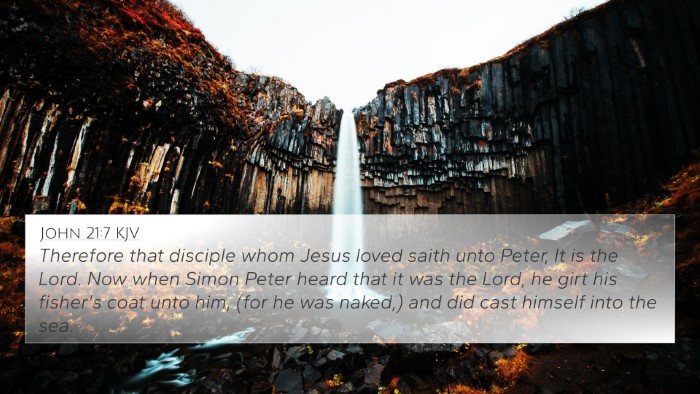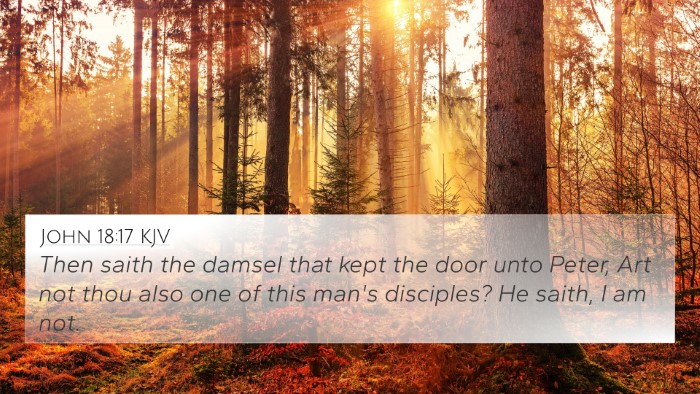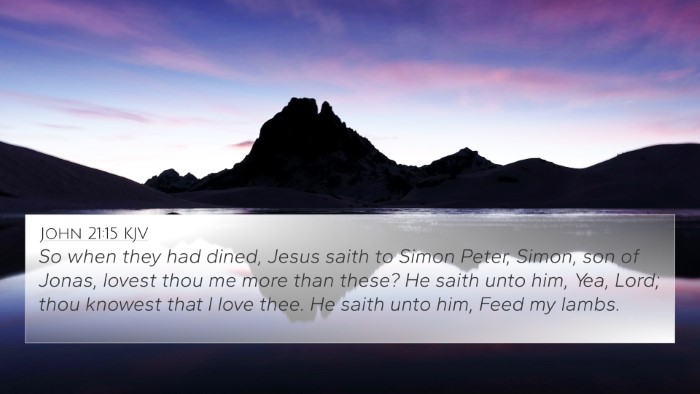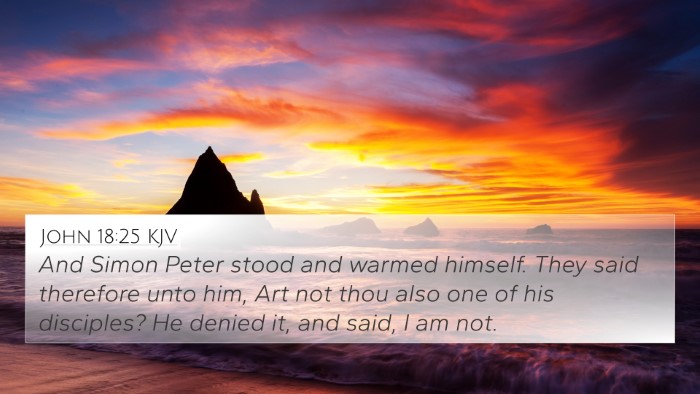Understanding John 20:6
John 20:6 states: "Then Simon Peter came, following him, and went into the tomb. He saw the linen cloths lying there." This verse is significant in the context of the resurrection narrative, capturing a moment when Peter inspects the tomb after the resurrection of Jesus Christ. Below, we explore various interpretations and meanings derived from public domain commentaries.
Summary of Insights
Matthew Henry's Commentary:
Henry elaborates on the urgency and excitement that led Peter to the tomb, emphasizing the role of Peter's impulsiveness in his character. The linen cloths are seen as a sign of Christ's resurrection, suggesting that His body did not simply rise but departed from the grave without disturbing the burial wraps. This reflects the divine nature of the resurrection, highlighting both the physical evidence and the miraculous power of God.
Albert Barnes' Notes:
Barnes focuses on the implication of the linen cloths' position, indicating that if someone had stolen Jesus' body, they would not have taken the time to unwrap the body completely. This investigation by Peter serves as a foundation for the resurrection's authenticity. He points out the importance of eyewitness accounts and physical evidence in establishing the truth of resurrection, which is central to Christian faith.
Adam Clarke's Commentary:
Clarke adds depth by considering the cultural significance of burial practices at the time. He notes how the orderly placement of the linen cloths reflects the deliberate nature of the resurrection, as if Jesus had exited the grave so effortlessly that the linens remained undisturbed. This detail lends credibility to the resurrection account and reassures the believer of its veracity.
Key Themes in John 20:6
- Evidence of Resurrection: The physical remains of linen cloths serve as a powerful testimony to the historical event of Jesus’ resurrection.
- Peter's Role: Peter’s investigative action illustrates leadership and the need for personal verification of faith.
- Miraculous Nature: The way Christ’s body left the grave indicates a miraculous, divine event rather than a natural occurrence.
Bible Verse Cross-References
- Luke 24:12: Peter runs to the tomb and sees the linen cloths.
- Matthew 28:6: The angel declares, "He is not here, for He has risen."
- John 11:44: The raising of Lazarus highlights the power of Jesus over death, paralleling His resurrection.
- Mark 16:5-6: The angel speaks to the women at the tomb, confirming Jesus’ resurrection.
- John 20:7: Specifically describes the napkin that had been on Jesus’ head, further emphasizing the miraculous event.
- Isaiah 53:10: Offers prophetic insight into the suffering of Christ, connecting the Old Testament with resurrection themes.
- Romans 8:11: Discusses the Spirit of God raising Jesus from the dead, reinforcing the theological implications of resurrection.
- 1 Corinthians 15:3-4: Paul defines the gospel, emphasizing the importance of Christ's death and resurrection.
- Acts 2:31-32: Peter’s proclamation of resurrection at Pentecost echoes the themes found in John 20:6.
- Philippians 3:10: Highlights the desire for the believer to know and experience the power of Christ’s resurrection.
Connections between Bible Verses
The connections between Bible verses provide a deeper understanding of themes presented in John 20:6. Through these verses, we see the thematic links of resurrection, faith, and the verification of Jesus' victory over death:
- Identifying the resurrection through Luke 24:12 emphasizes personal involvement in discovering truth.
- Cross-references with Matthew 28:6 and Mark 16:5-6 show the continuity of the resurrection message across the gospels.
- The connection with 1 Corinthians 15:3-4 highlights the foundational doctrine of resurrection for Christian faith.
Thematic Bible Verse Connections
The resurrection account is central to Christian doctrine, and John 20:6 serves as a pivotal point for various discussions including:
- The nature of faith: Through Peter’s actions, we see the interplay between seeing and believing.
- Historical context: The burial customs of the time inform the understanding of resurrection.
- Discipleship: The responses of Peter and others reveal much about their character and leadership in establishing the Church.
This exploration of John 20:6 illustrates not just a moment in time, but a profound theological truth that resonates through scripture, connecting believers to the heart of the Christian faith—the resurrection of Jesus Christ. By utilizing tools for Bible cross-referencing, one can deepen their understanding of this pivotal event.

